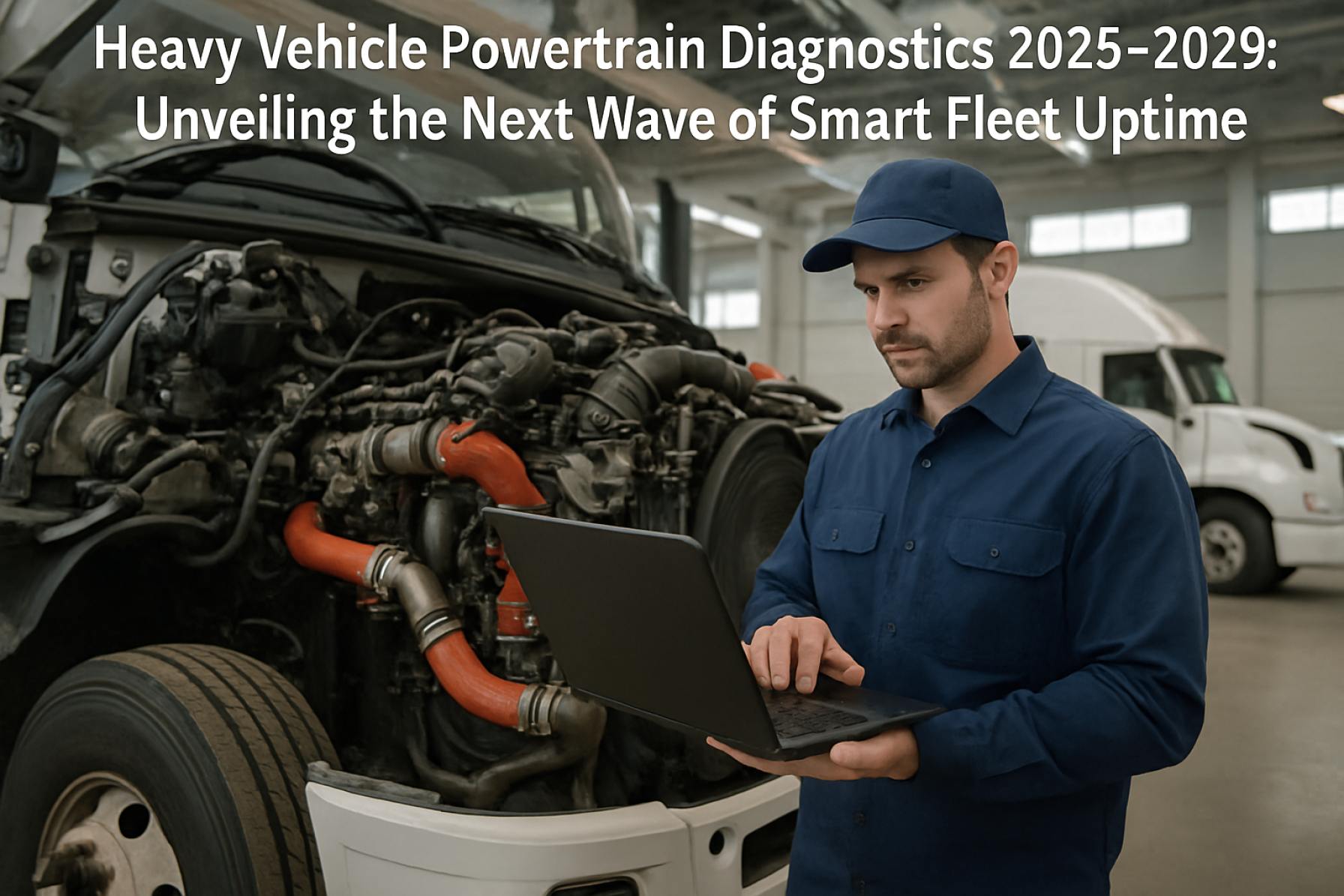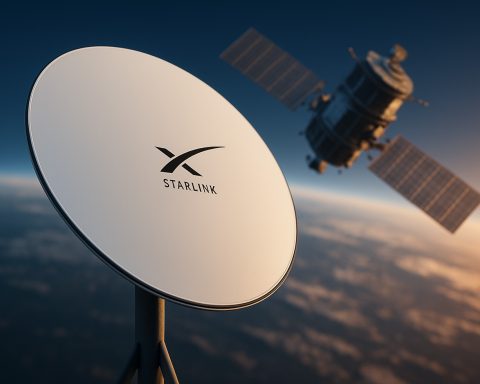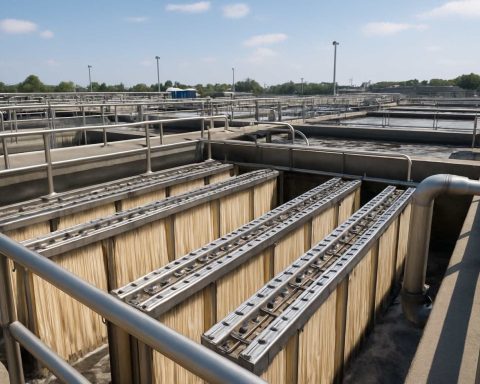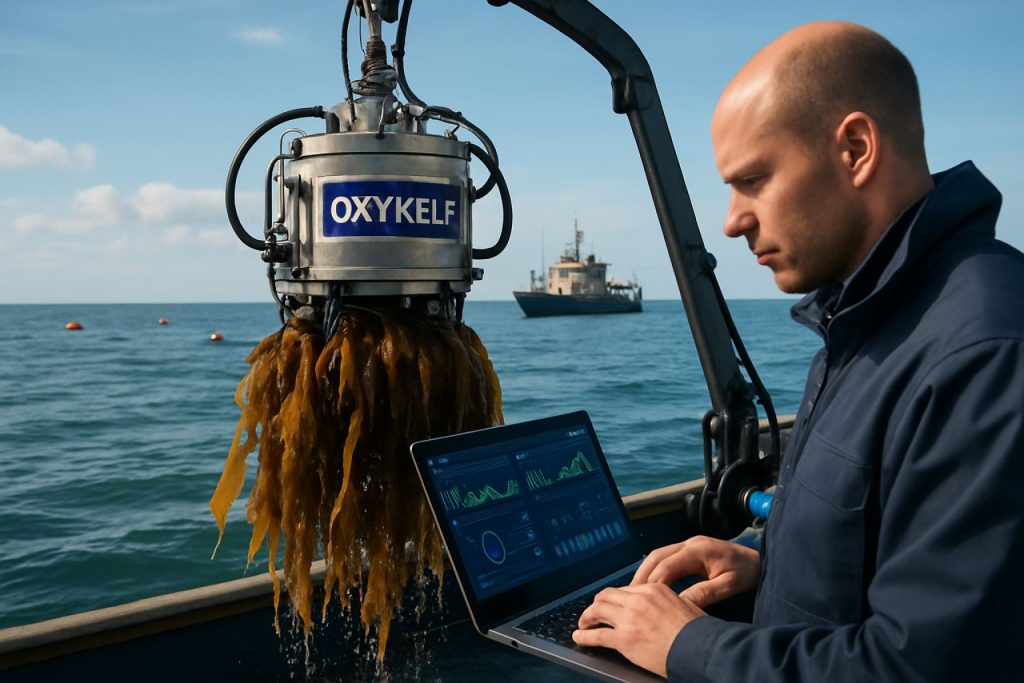Table of Contents
- Executive Summary: The State of Heavy Vehicle Powertrain Diagnostics in 2025
- Market Size, Growth Trends, and Forecasts to 2029
- Emerging Technologies: AI, IoT, and Predictive Analytics in Powertrain Diagnostics
- OEM & Supplier Innovations: Key Players and Their Latest Diagnostic Solutions
- Connectivity and Telematics: Real-Time Monitoring and Data Integration
- Regulatory Drivers and Compliance Requirements Impacting Diagnostics
- Challenges: Data Security, Standardization, and Integration Barriers
- Case Studies: Fleet Success Stories and Diagnostic ROI
- Competitive Landscape: Strategic Partnerships and Ecosystem Evolution
- Future Outlook: Autonomous Diagnostics, Remote Servicing, and Next-Gen Opportunities
- Sources & References
Executive Summary: The State of Heavy Vehicle Powertrain Diagnostics in 2025
In 2025, the heavy vehicle powertrain diagnostics sector is undergoing significant transformation driven by regulatory pressures, advanced connectivity, and the growing complexity of vehicle architectures. The proliferation of emissions and safety standards globally is compelling manufacturers and fleet operators to adopt more sophisticated diagnostic solutions to ensure compliance and operational efficiency.
A defining event shaping the industry in 2025 is the widespread integration of remote diagnostics and predictive maintenance technologies, particularly in response to tightening emissions standards in North America, Europe, and parts of Asia. Companies such as Cummins Inc. and Daimler Truck AG have expanded their telematics offerings, enabling real-time monitoring of powertrain health and early detection of faults. This shift is reducing unplanned downtime and optimizing maintenance schedules, as fleets leverage data-driven insights to maximize vehicle uptime.
Adoption of advanced diagnostic tools is also being propelled by the increasing presence of electrified and hybrid powertrains. Diagnostics now must address not only traditional engine and transmission systems but also high-voltage batteries, inverters, and electric drive modules. Companies like Volvo Trucks are deploying enhanced onboard diagnostic (OBD) systems tailored to these new technologies, supporting both regulatory compliance and operational reliability.
- Telematics platforms such as PACCAR’s Connected Truck and Navistar’s OnCommand Connection are reporting increased adoption rates, with fleets using aggregated diagnostic data to drive cost savings and improve asset utilization.
- There is a notable rise in over-the-air (OTA) software updates, allowing manufacturers like Mack Trucks to remotely address diagnostic trouble codes and deploy fixes, reducing the need for physical service visits.
- Regulatory frameworks, such as the EU’s Euro VII proposal and California’s Advanced Clean Trucks regulation, are accelerating the deployment of real-time emissions monitoring and diagnostics in heavy vehicles.
Looking ahead, the next few years are expected to bring further integration of artificial intelligence and machine learning into diagnostic platforms, enabling even more accurate fault prediction and maintenance optimization. As heavy vehicle electrification accelerates, diagnostics solutions will continue to evolve, with manufacturers investing heavily in software and connectivity infrastructure to support this transition. The convergence of regulatory requirements, technological innovation, and operational demands is setting a new baseline for powertrain diagnostics, positioning the sector for robust growth and continual advancement.
Market Size, Growth Trends, and Forecasts to 2029
The market for heavy vehicle powertrain diagnostics is undergoing notable expansion as fleets and OEMs increasingly prioritize uptime, regulatory compliance, and advanced maintenance. As of 2025, the adoption of telematics and connected diagnostics solutions is accelerating, driven by the need to reduce total cost of ownership and meet stringent emissions and safety standards. Major commercial vehicle manufacturers are integrating advanced onboard diagnostic (OBD) and prognostic systems directly into new models, enabling real-time monitoring of engine, transmission, aftertreatment, and driveline components.
Global demand is particularly strong in North America and Europe, where regulatory frameworks such as the European Union’s Euro VI standards and the US Environmental Protection Agency’s GHG Phase 2 regulations necessitate sophisticated diagnostics for compliance and warranty management. Leading truck OEMs, including Daimler Truck, Volvo Trucks, and PACCAR, have expanded their digital service portfolios to include remote diagnostics and predictive maintenance platforms, which are increasingly standard features in heavy-duty vehicles.
The proliferation of connected vehicle technologies is also spurring growth. Companies such as Cummins and ZF have launched cloud-based diagnostic services that aggregate and analyze powertrain data from large fleets, delivering actionable insights to operators and service technicians. According to Navistar, remote diagnostics solutions have helped reduce diagnostic times by up to 70%, minimizing unplanned downtime and supporting fleet efficiency initiatives.
Looking ahead to 2029, market growth is expected to be reinforced by continued electrification and hybridization of commercial vehicles. Diagnostic platforms are evolving to address the unique needs of electric powertrains, including battery health monitoring and high-voltage component diagnostics. Volvo Trucks and Daimler Truck have both introduced diagnostic tools specifically tailored for electric drivetrains, reflecting a shift in aftermarket service requirements.
- Integration of artificial intelligence and machine learning is anticipated to further improve predictive maintenance accuracy and reduce false positives.
- Aftermarket and third-party solution providers are expected to capture increased share by offering OEM-agnostic diagnostic platforms compatible with mixed fleets.
- Expansion into emerging markets—especially Asia-Pacific—is forecasted as local regulatory frameworks and fleet digitalization initiatives mature.
In summary, the heavy vehicle powertrain diagnostics market is set for sustained growth through 2029, underpinned by regulatory drivers, advances in connectivity, and the transition toward alternative powertrains, with leading OEMs and Tier-1 suppliers actively shaping the competitive landscape.
Emerging Technologies: AI, IoT, and Predictive Analytics in Powertrain Diagnostics
The integration of artificial intelligence (AI), Internet of Things (IoT), and predictive analytics is rapidly reshaping the landscape of heavy vehicle powertrain diagnostics as of 2025. These technologies are addressing the increasing complexity of modern powertrains, especially as fleets incorporate electrified, hybrid, and advanced combustion engines to meet stricter emissions and efficiency standards.
Currently, leading commercial vehicle manufacturers are embedding a dense network of IoT sensors across engines, transmissions, and drivetrains to transmit real-time performance data. For instance, Daimler Truck is leveraging its digital platforms to collect and analyze data from thousands of connected trucks globally, enabling remote diagnostics and condition monitoring. Similarly, Volvo Trucks offers connected service solutions using onboard telematics to provide continuous powertrain health assessments and facilitate predictive maintenance.
AI-driven analytics are now able to process the vast data streams from IoT devices to predict component wear, detect anomalies, and recommend preemptive actions—significantly reducing unplanned downtime. Cummins has deployed its Connected Diagnostics platform, which uses machine learning algorithms to interpret engine fault codes and provide actionable insights directly to fleet operators and service technicians. This system can identify subtle degradation patterns in powertrain components before they result in critical failures.
Looking ahead to the next few years, the trend is expected to accelerate with the adoption of even more advanced AI models and edge computing. This will allow real-time diagnostics and decision-making directly on the vehicle, reducing reliance on cloud connectivity and enabling immediate safety interventions. ZF Friedrichshafen AG is actively expanding its digital portfolio for commercial vehicles, with AI-powered solutions that monitor transmission and axle health, and integrate with fleet management systems for holistic powertrain oversight.
- Deployment of over-the-air (OTA) software updates for diagnostic algorithms is becoming common, as seen in offerings from PACCAR, ensuring diagnostic capabilities evolve alongside new powertrain technologies.
- Regulatory pressures for emissions compliance are driving OEMs and suppliers to invest in predictive analytics capable of flagging deviations in engine or aftertreatment systems, supporting both uptime and regulatory reporting.
- Collaborations between vehicle makers and technology firms are expected to yield new AI-powered platforms, improving fault detection accuracy and further automating the diagnostic process.
In summary, the convergence of AI, IoT, and predictive analytics in heavy vehicle powertrain diagnostics is delivering measurable improvements in fleet reliability, cost efficiency, and regulatory compliance as of 2025, with transformative advancements expected as these technologies mature.
OEM & Supplier Innovations: Key Players and Their Latest Diagnostic Solutions
The landscape of heavy vehicle powertrain diagnostics is rapidly evolving in 2025, driven by major original equipment manufacturers (OEMs) and Tier 1 suppliers integrating advanced digital solutions for enhanced fleet uptime, efficiency, and regulatory compliance. Key players are leveraging cloud-based analytics, remote monitoring, and artificial intelligence (AI) to transform traditional diagnostic approaches.
Leading the way, Daimler Truck has expanded its Detroit Connect platform, which now provides real-time, over-the-air (OTA) diagnostics for its Freightliner and Western Star models. The platform uses predictive analytics to identify potential powertrain faults, allowing for proactive maintenance scheduling and minimizing unplanned downtime. Volvo Trucks offers its Remote Diagnostics solution across its heavy-duty lineup, facilitating instant fault code analysis and expert recommendations directly to fleet managers and service centers. This system processes millions of diagnostic events per year, enabling faster repair decisions and improved vehicle uptime.
Suppliers are also pushing the boundaries of diagnostic technology. Bosch Mobility has introduced its next-generation ESI[tronic] 2.0 Online diagnostic software, featuring expanded heavy-duty coverage and integrated cloud connectivity. The solution supports comprehensive powertrain troubleshooting, including diesel, alternative fuel, and emerging electric drivetrains, reflecting the transition towards low- and zero-emission vehicles. ZF Group, another major supplier, has integrated its Openmatics digital platform with advanced diagnostics modules, enabling continuous monitoring of transmissions and hybrid systems in heavy vehicles. These tools utilize edge computing and AI to detect anomalies and recommend corrective actions before failures occur.
Looking ahead, OEMs like Scania are piloting AI-powered diagnostic assistants that combine telematics data with historical repair records to predict complex powertrain issues, especially as electrified and hybrid vehicles become more prevalent. Meanwhile, Cummins has enhanced its Guidanz platform in 2025 with the ability to deliver real-time diagnostic data and service recommendations for both traditional diesel engines and its new range of hydrogen and battery-electric powertrains.
With stricter emissions standards and the shift toward electrification, the next few years will see further integration of advanced sensors, secure connectivity, and machine learning in powertrain diagnostics. The collaboration between OEMs and technology suppliers is expected to accelerate, ensuring heavy vehicle fleets benefit from predictive, data-driven maintenance and reduced total cost of ownership.
Connectivity and Telematics: Real-Time Monitoring and Data Integration
In 2025, the integration of connectivity and telematics into heavy vehicle powertrain diagnostics is advancing rapidly, driven by the need for greater operational efficiency, uptime, and regulatory compliance. The latest generation of commercial vehicles is increasingly equipped with sophisticated telematics control units (TCUs) and on-board diagnostics (OBD) systems that communicate real-time data on powertrain health, performance anomalies, and predictive maintenance requirements directly to fleet operators and manufacturers.
Major OEMs and tier-one suppliers have rolled out advanced remote diagnostics platforms. For example, Daimler Truck offers its Truck Connectivity platform, which enables continuous monitoring of critical powertrain parameters such as engine temperature, oil pressure, and transmission behavior. These data streams are analyzed using cloud-based algorithms to predict failures and recommend service interventions, significantly reducing unplanned downtime.
Similarly, Volvo Trucks has expanded its Volvo Connect telematics suite to include enhanced diagnostics for electric and conventional drivetrains. The system aggregates sensor data from the entire powertrain, providing actionable insights to drivers and fleet managers through an integrated dashboard. This holistic approach supports real-time alerts and remote troubleshooting, allowing service centers to pre-diagnose issues and dispatch technicians with the necessary parts and knowledge.
Suppliers such as ZF Friedrichshafen AG have introduced open-platform telematics solutions that interface with multiple vehicle brands and powertrain architectures. Their solutions enable cross-fleet diagnostics, making them invaluable for mixed fleets and logistics companies seeking to standardize maintenance practices across diverse assets.
Beyond OEM offerings, integration with wider fleet management and enterprise systems is accelerating. For example, Cummins Inc. has developed its Powertrain Intelligence platform, which not only monitors engine and transmission parameters but also synthesizes this data with route, load, and driver behavior information. This level of integration supports advanced prognostics, helping fleets anticipate powertrain wear and optimize service schedules.
Looking ahead, industry bodies such as the SAE International are refining standards like J1939 to facilitate greater interoperability and secure data exchange between connected systems. With regulatory pressure mounting around emissions and uptime, real-time powertrain diagnostics and data integration are expected to become baseline requirements for heavy vehicle fleets by the late 2020s.
Regulatory Drivers and Compliance Requirements Impacting Diagnostics
Regulatory frameworks worldwide are intensifying their focus on emissions, fuel efficiency, and safety in the heavy vehicle sector, directly influencing the evolution of powertrain diagnostics. In 2025, these regulations are driving manufacturers and fleet operators to adopt more advanced, real-time diagnostic systems to ensure compliance and to preemptively address potential violations.
One of the most significant regulatory drivers is the adoption of stricter emissions standards. The European Union’s “Euro VII” proposal, anticipated to take effect within the next few years, will impose tougher limits on NOx and particulate emissions for heavy-duty vehicles. This mandates that Original Equipment Manufacturers (OEMs) integrate sophisticated onboard diagnostics (OBD) systems capable of continuously monitoring emissions performance and alerting operators to any deviations or malfunctions in aftertreatment systems such as selective catalytic reduction (SCR) and diesel particulate filters (DPF) (DAF Trucks).
In the United States, the Environmental Protection Agency (EPA) has updated its Clean Trucks Plan, introducing new standards for greenhouse gas (GHG) and criteria pollutant emissions through 2027 and beyond. These regulations require manufacturers to implement more robust diagnostic tools to monitor engine and aftertreatment system health, ensuring compliance over the vehicle’s useful life. The EPA specifically calls for improvements in OBD capabilities, including enhanced fault detection and reporting, as well as tamper-resistant design (United States Environmental Protection Agency).
Additionally, California’s unique regulatory environment—through the California Air Resources Board (CARB)—often sets more stringent standards that ripple through the industry. CARB’s Heavy-Duty Inspection and Maintenance (HD I/M) program, which began implementation in 2023 and will be further enforced in 2025, requires periodic emissions system checks using onboard diagnostics. Vehicles failing to meet OBD or emissions standards can be barred from operation, underscoring the criticality of advanced diagnostics for fleet compliance (California Air Resources Board).
Looking forward, industry bodies such as the SAE International and the European Automobile Manufacturers Association (ACEA) are working on harmonizing diagnostic protocols and data access standards, aiming to facilitate interoperability, remote diagnostics, and secure over-the-air (OTA) updates. These collaborative efforts are expected to expand the role and capabilities of diagnostics, ensuring not only regulatory compliance but also supporting broader goals in sustainability, operational efficiency, and digital fleet management.
Challenges: Data Security, Standardization, and Integration Barriers
Heavy vehicle powertrain diagnostics are undergoing rapid transformation as digitalization, cloud connectivity, and predictive analytics become increasingly embedded in commercial vehicle fleets. However, these advances bring significant challenges related to data security, standardization, and system integration—issues that are particularly acute in the context of heavy-duty vehicles, given their operational complexity and the critical nature of their functions.
Data Security: As diagnostic systems are increasingly connected—often transmitting real-time powertrain data to OEMs or fleet managers—cybersecurity becomes a top concern. Unauthorized access to vehicle data or control systems can have safety, privacy, and operational implications. Leading OEMs are investing in secure gateways and encrypted communications for telematics and over-the-air (OTA) diagnostics. For example, Daimler Truck and Volvo Trucks both highlight the importance of secure data handling in their connected vehicle solutions. As the industry moves toward 2025, compliance with evolving cyber standards—such as ISO/SAE 21434 for vehicle cybersecurity engineering—will be increasingly mandatory.
Standardization: The powertrain diagnostic landscape suffers from a proliferation of proprietary protocols and interfaces, which hinders interoperability and complicates diagnostics across mixed-brand fleets. Industry-wide efforts, such as the adoption of standardized communication protocols like SAE J1939 and the implementation of ODX (Open Diagnostic Data Exchange), are gaining momentum. Organizations such as the SAE International are working on updates to diagnostic standards to address the complexities of new powertrain architectures, including electrified and hybrid systems. Nevertheless, achieving universal compatibility remains elusive, particularly as OEMs introduce unique features to differentiate their smart diagnostic offerings.
Integration Barriers: Integrating diagnostic data from disparate sources—engines, transmissions, battery management systems (for electric vehicles)—into unified fleet management platforms is a persistent hurdle. Data silos, legacy systems, and varying data formats challenge seamless integration. Manufacturers like Cummins and ZF Friedrichshafen AG are investing in scalable, open-platform solutions to better aggregate and interpret diagnostic data from multiple subsystems. Yet, as vehicle architectures diversify, integration complexity is expected to rise over the next several years.
Looking ahead, resolving these challenges will be critical to unlocking the full potential of predictive diagnostics and remote monitoring. Industry collaboration on security, data standards, and open integration frameworks will shape the landscape for heavy vehicle powertrain diagnostics through 2025 and beyond.
Case Studies: Fleet Success Stories and Diagnostic ROI
In 2025, heavy vehicle fleets are increasingly leveraging advanced powertrain diagnostics to optimize operations, reduce costs, and improve uptime. Real-world case studies from major fleet operators and OEMs highlight both the tangible and strategic value of these diagnostic solutions.
One prominent example is Daimler Truck’s Fleetboard system, which integrates powertrain diagnostics across its global fleet. By using real-time data from engines, transmissions, and aftertreatment systems, Fleetboard enabled a major European logistics provider to reduce unplanned breakdowns by 30% and lower maintenance costs by 12% over a 12-month period in 2024-2025. These gains were largely attributed to the system’s predictive analytics, which anticipated component wear and scheduled maintenance proactively, minimizing costly downtime.
Similarly, PACCAR’s SmartLINQ platform, deployed across thousands of Kenworth and Peterbilt trucks in North America, has delivered measurable ROI for fleet operators. In a 2025 review, US-based carrier Stevens Transport reported a 20% decrease in roadside events and a 15% increase in vehicle availability after implementing SmartLINQ diagnostics. The platform’s ability to remotely monitor powertrain health and alert maintenance teams to emerging issues helped optimize service intervals and reduce emergency repairs.
Another notable case is Volvo Trucks’ Remote Diagnostics service. In 2025, a leading Canadian refrigerated transport fleet used Volvo’s system to monitor engine parameters, transmission performance, and aftertreatment efficiency across its vehicles. By integrating diagnostic insights with their fleet management software, the company shortened repair planning time by 40% and increased first-time fix rates, translating to significant cost savings and improved customer service reliability.
ROI from powertrain diagnostics is not limited to cost reduction. Cummins has documented cases where its Connected Diagnostics solution provided emissions compliance insights, helping fleets avoid regulatory penalties and optimize fuel efficiency. In one 2025 deployment, a regional bus operator leveraged Cummins diagnostics to improve fuel economy by 5% while maintaining emissions standards, demonstrating value beyond traditional maintenance metrics.
Looking ahead, as electric and hybrid powertrains become more prevalent in heavy vehicles, fleet success stories increasingly focus on battery health analytics and electric drive monitoring. OEMs and tech providers are expected to showcase more case studies on the ROI of next-generation diagnostics, particularly as fleets transition to zero-emission vehicles and demand even greater uptime and efficiency.
Competitive Landscape: Strategic Partnerships and Ecosystem Evolution
The competitive landscape for heavy vehicle powertrain diagnostics in 2025 is defined by increasing collaboration between OEMs, Tier 1 suppliers, telematics providers, and software specialists. This strategic shift is driven by the need to address evolving emissions standards, electrification, and the rising complexity of powertrain systems. Leading manufacturers such as Daimler Truck AG and Volvo Trucks are expanding their digital service offerings with embedded diagnostic capabilities, leveraging extensive partnerships with technology companies.
A notable trend in 2025 is the integration of advanced remote diagnostics and prognostics. For example, Cummins Inc. continues to grow its Connected Diagnostics platform, collaborating with fleet management systems to deliver real-time powertrain health assessments. Similarly, ZF Friedrichshafen AG partners with commercial vehicle OEMs to embed predictive maintenance algorithms within transmission and driveline control units, optimizing uptime and reducing total cost of ownership for fleets.
The evolution of the ecosystem also sees software and telematics vendors playing a prominent role. Bosch Mobility collaborates with truck manufacturers and independent service networks to harmonize diagnostic protocols across different brands, addressing the challenge of mixed fleets. Meanwhile, Allison Transmission has launched enhanced diagnostic tools compatible with both diesel and electric propulsion systems, reflecting the shift toward electrified heavy vehicles.
- In 2025, major OEMs are increasingly opening their diagnostic data interfaces to trusted partners, fostering interoperability and third-party innovation.
- There is a growing focus on secure over-the-air (OTA) updates, with partnerships between telematics companies and cybersecurity specialists to safeguard sensitive powertrain data.
- Collaborative pilot projects are underway to utilize AI-powered analytics for early fault detection, involving stakeholders such as Navistar and leading component suppliers.
Looking forward, the next few years are expected to bring deeper integration of AI-driven diagnostics, further consolidation of data-sharing alliances, and the emergence of standardized platforms facilitating ecosystem-wide collaboration. These developments will be crucial for managing the increasing complexity and electrification of heavy vehicle powertrains, ensuring sustained competitiveness and regulatory compliance across global markets.
Future Outlook: Autonomous Diagnostics, Remote Servicing, and Next-Gen Opportunities
Looking ahead to 2025 and the coming years, the landscape of heavy vehicle powertrain diagnostics is experiencing rapid transformation, driven by advances in digitalization, connectivity, and automation. Leading manufacturers and tier-one suppliers are heavily investing in next-generation diagnostic solutions that leverage artificial intelligence (AI), machine learning, and telematics to address increasingly complex powertrain architectures—especially as fleets diversify with hybrid and electric drivetrains.
A key trend is the integration of autonomous diagnostics systems capable of real-time condition monitoring and predictive analytics. For instance, Cummins Inc. has rolled out its Connected Diagnostics platform, which continuously monitors engine and aftertreatment system data, automatically alerts fleet managers to developing issues, and recommends actionable service steps. Similarly, Daimler Truck AG offers Remote Truck Services that enable remote diagnostics for its trucks worldwide, allowing service centers to access vehicle health reports and fault codes before the vehicle even arrives at the workshop.
Remote servicing is becoming increasingly viable as over-the-air (OTA) updates and remote calibration gain traction. Volvo Trucks has successfully piloted OTA software update capabilities for powertrain control modules, reducing vehicle downtime and enhancing operational efficiency. These remote interventions not only minimize the need for physical shop visits but also pave the way for more proactive and less disruptive maintenance regimes.
The ongoing electrification of heavy-duty fleets is introducing new diagnostic challenges and opportunities. Powertrain diagnostic tools are evolving to address high-voltage components, battery management systems, and complex software integrations. ZF Friedrichshafen AG is expanding its digital diagnostics suite to support both conventional and electric powertrains, leveraging cloud-based analytics to optimize vehicle uptime and component life cycles.
Looking forward, the proliferation of vehicle-to-cloud connectivity and enhanced onboard computing power will enable even more autonomous, self-diagnosing vehicles. These advancements are expected to accelerate with the deployment of 5G networks, which will support higher data volumes and lower latency for real-time diagnostics and remote interventions. Industry bodies such as the SAE International are actively working on standardizing diagnostic protocols for mixed powertrain fleets, ensuring interoperability and data security as these technologies mature.
In summary, the next few years will see heavy vehicle powertrain diagnostics become increasingly autonomous, data-driven, and remotely managed, unlocking new opportunities for uptime optimization, cost savings, and predictive fleet health management.











